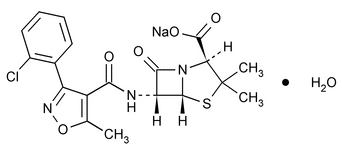Cloxacillin Sodium
(klox'' a sil' in soe' dee um).
4-Thia-1-azabicyclo[3.2.0]heptane-2-carboxylic acid, 6-[[[3-(2-chlorophenyl)-5-methyl-4-isoxazolyl]carbonyl]amino]-3,3-dimethyl-7-oxo-, monosodium salt, monohydrate, [2S-(2
Monosodium (2S,5R,6R)-6-[3-(o-chlorophenyl)-5-methyl-4-isoxazolecarboxamido]-3,3-dimethyl-7-oxo-4-thia-1-azabicyclo[3.2.0]heptane-2-carboxylate monohydrate
Anhydrous 457.87
» Cloxacillin Sodium contains the equivalent of not less than 825 µg of cloxacillin (C19H18ClN3O5S) per mg.
Packaging and storage—
Preserve in tight containers, and store at a temperature not exceeding 25 .
.
Labeling—
Where it is intended for use in preparing sterile dosage forms, the label states that it is sterile or must be subjected to further processing during the preparation of sterile dosage forms.
Crystallinity  695
695 :
meets the requirements.
:
meets the requirements.
Sterility  71
71 —
Where the label states that Cloxacillin Sodium is sterile, it meets the requirements when tested as directed for Direct Inoculation of the Culture Medium under Test for Sterility of the Product to be Examined, except to use Fluid Thioglycollate Medium containing polysorbate 80 solution (1 in 200) and an amount of sterile penicillinase sufficient to inactivate the cloxacillin in each tube, to use Soybean–Casein Digest Medium containing polysorbate 80 solution (1 in 200) and an amount of sterile penicillinase sufficient to inactivate the cloxacillin in each tube, and to shake the tubes once daily.
—
Where the label states that Cloxacillin Sodium is sterile, it meets the requirements when tested as directed for Direct Inoculation of the Culture Medium under Test for Sterility of the Product to be Examined, except to use Fluid Thioglycollate Medium containing polysorbate 80 solution (1 in 200) and an amount of sterile penicillinase sufficient to inactivate the cloxacillin in each tube, to use Soybean–Casein Digest Medium containing polysorbate 80 solution (1 in 200) and an amount of sterile penicillinase sufficient to inactivate the cloxacillin in each tube, and to shake the tubes once daily.
pH  791
791 :
between 4.5 and 7.5, in a solution containing 10 mg per mL.
:
between 4.5 and 7.5, in a solution containing 10 mg per mL.
Water, Method I  921
921 :
between 3.0% and 5.0%.
:
between 3.0% and 5.0%.
Dimethylaniline  223
223 :
meets the requirement.
:
meets the requirement.
Assay—
Buffer—
Prepare a 0.02 M solution of monobasic potassium phosphate in water, and adjust with 2 N sodium hydroxide to a pH of 6.8.
Mobile phase—
Prepare a mixture of Buffer and acetonitrile (80:20). Make adjustments if necessary (see System Suitability under Chromatography  621
621 ).
).
Standard preparation—
Prepare a solution of USP Cloxacillin Sodium RS in Buffer having a known concentration of about 0.55 mg per mL.
Assay preparation—
Transfer about 110 mg of Cloxacillin Sodium, accurately weighed, to a 200-mL volumetric flask, dilute with Buffer to volume, and mix. Stir with the aid of a magnetic stirrer for 5 minutes to dissolve.
Chromatographic system (see Chromatography  621
621 )—
The liquid chromatograph is equipped with a 225-nm detector and a 4.6-mm × 25-cm column that contains packing L1. The flow rate is about 1 mL per minute. Chromatograph the Standard preparation, and record the peak responses as directed for Procedure: the tailing factor is not more than 1.8; and the relative standard deviation for replicate injections is not more than 2.0%.
)—
The liquid chromatograph is equipped with a 225-nm detector and a 4.6-mm × 25-cm column that contains packing L1. The flow rate is about 1 mL per minute. Chromatograph the Standard preparation, and record the peak responses as directed for Procedure: the tailing factor is not more than 1.8; and the relative standard deviation for replicate injections is not more than 2.0%.
Procedure—
Separately inject equal volumes (about 20 µL) of the Standard preparation and the Assay preparation into the chromatograph, record the chromatograms, and measure the responses for the major peaks. Calculate the quantity, in µg, of cloxacillin (C19H18ClN3O5S) in each mg of Cloxacillin Sodium taken by the formula:
200(CE / W)(rU / rS)
in which C is the concentration, in mg per mL, of USP Cloxacillin Sodium RS in the Standard preparation; E is the cloxacillin (C19H18ClN3O5S) equivalent, in µg per mg, of USP Cloxacillin Sodium RS; W is the weight, in mg, of Cloxacillin Sodium taken to prepare the Assay preparation; and rU and rS are the cloxacillin peak responses obtained from the Assay preparation and the Standard preparation, respectively.
Auxiliary Information—
Please check for your question in the FAQs before contacting USP.
| Topic/Question | Contact | Expert Committee |
|---|---|---|
| Monograph | Ahalya Wise, M.S.
Senior Scientific Liaison 1-301-816-8161 |
(SM12010) Monographs - Small Molecules 1 |
| Reference Standards | RS Technical Services 1-301-816-8129 rstech@usp.org |
|
| Radhakrishna S Tirumalai, Ph.D.
Principal Scientific Liaison 1-301-816-8339 |
(GCM2010) General Chapters - Microbiology |
USP35–NF30 Page 2747
Pharmacopeial Forum: Volume No. 28(4) Page 1091

